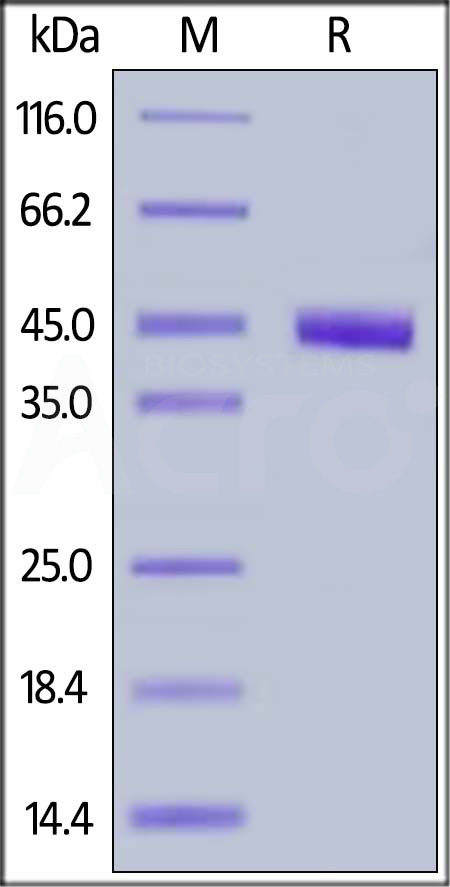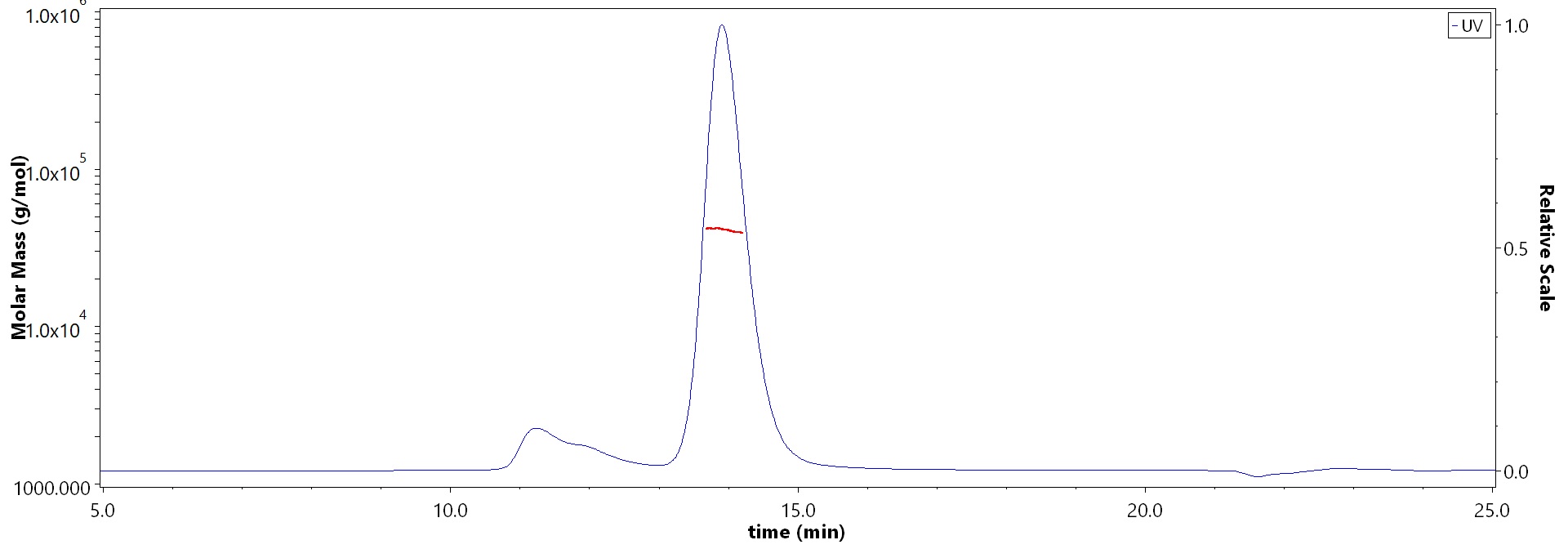分子别名(Synonym)
NECTIN4,LNIR, PRR4, PVRL4
表达区间及表达系统(Source)
Cynomolgus Nectin-4, His Tag (NE4-C52H4) is expressed from human 293 cells (HEK293). It contains AA Gly 32 - Ser 349 (Accession # XP_005541277.1).
Predicted N-terminus: Gly 32
Request for sequence
蛋白结构(Molecular Characterization)

This protein carries a polyhistidine tag at the C-terminus.
The protein has a calculated MW of 36.0 kDa. The protein migrates as 40-45 kDa under reducing (R) condition (SDS-PAGE) due to glycosylation.
内毒素(Endotoxin)
Less than 1.0 EU per μg by the LAL method.
纯度(Purity)
>95% as determined by SDS-PAGE.
制剂(Formulation)
Lyophilized from 0.22 μm filtered solution in PBS, pH7.4 with trehalose as protectant.
Contact us for customized product form or formulation.
重构方法(Reconstitution)
Please see Certificate of Analysis for specific instructions.
For best performance, we strongly recommend you to follow the reconstitution protocol provided in the CoA.
存储(Storage)
For long term storage, the product should be stored at lyophilized state at -20°C or lower.
Please avoid repeated freeze-thaw cycles.
This product is stable after storage at:
- -20°C to -70°C for 12 months in lyophilized state;
- -70°C for 3 months under sterile conditions after reconstitution.
质量管理控制体系(QMS)
电泳(SDS-PAGE)

Cynomolgus Nectin-4, His Tag on SDS-PAGE under reducing (R) condition. The gel was stained with Coomassie Blue. The purity of the protein is greater than 95%.
SEC-MALS

The purity of Cynomolgus Nectin-4, His Tag (Cat. No. NE4-C52H4) is more than 85% and the molecular weight of this protein is around 35-55 kDa verified by SEC-MALS.
Report
活性(Bioactivity)-ELISA

Immobilized Cynomolgus Nectin-4, His Tag (Cat. No. NE4-C52H4) at 1 μg/mL (100 μL/well) can bind Mouse Anti-Nectin-4 Antibody with a linear range of 0.1-2 ng/mL (QC tested).
Protocol
活性(Bioactivity)-SPR

Mouse Anti-Nectin-4 Antibody (Mouse IgG1) captured on CM5 chip via anti-mouse antibodies surface can bind Cynomolgus Nectin-4, His Tag (Cat. No. NE4-C52H4) with an affinity constant of 824 nM as determined in a SPR assay (Biacore T200) (Routinely tested).
Protocol
活性(Bioactivity)-BLI

Loaded Cynomolgus Nectin-4, His Tag (Cat. No. NE4-C52H4) on HIS1K Biosensor, can bind Human Nectin-1, Fc Tag (Cat. No. PV1-H5253) with an affinity constant of 0.23 μM as determined in BLI assay (ForteBio Octet Red96e) (Routinely tested).
Protocol
 +添加评论
+添加评论
- 188XXXXXXX5
- 采购该蛋白Cynomolgus Nectin-4 Protein, His Tag的应用用途为杂交瘤抗体先导分子,与猴的种属交叉检测检测。与阳参抗体的ELISA亲和结果显示该蛋白具有良好的亲和活性,
- 2021-7-17

- 150XXXXXXX2
- We purchased this protein to verify the affinity of antibodies during screening. Preliminary ELISA testing indicated that its affinity performance is remarkably stable, bolstering our confidence in subsequent experiments. Shortly thereafter, we conducted SPR testing, and the results were highly satisfactory. We anticipate that this protein will maintain its exceptional performance in future cell experiments, providing invaluable data support for our research.
- 2024-4-10

- 188XXXXXXX0
- 之前使用过Fc标签的Cynomolgus Nectin-4蛋白,在抗体表达验证中活性非常稳定,本次又选择该货号His标签的蛋白,ELISA检测发现蛋白特异性高,且亲和力稳定,数据很符合预期,百普塞斯蛋白质量真心不错啊。
- 2024-5-10
背景(Background)
Nectin-4 (gene name PVRL4, poliovirus receptor-like 4) is a 66 kDa type I transmembrane glycoprotein belonging to the Nectin family of Ig superfamily proteins. Nectins are cell adhesion molecules that play a key role in various biological processes such as polarity, proliferation, differentiation and migration, for epithelial, endothelial, immune and neuronal cells, during development and adult life. Nectin-4 is a tumor-associated antigen in 50%, 49% and 86%o of breast, ovarian and lung carcinomas, respectively, mostly on tumors of bad prognosis. Its expression is not detected in the corresponding normal tissues.























































 膜杰作
膜杰作 Star Staining
Star Staining















